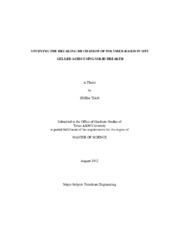| dc.description.abstract | In situ gelled acids that are based on polymers have been used in the field for several years as an acid diversion agent. These acids should not cause permanent formation damage, and should clean-up rapidly and completely when the well is put back on production. However, recent lab studies indicated that a significant amount of gel was retained inside the core even when the recommended breaker concentration was used. This gel significantly reduced the core permeability. Therefore, the objective of this study is to examine the working mechanisms of the solid breaker and the factors that affect the breaking time. The flowback of the spent acid and the core damage induced by it will also be assessed in detail.
Viscosity and rheological experimental studies were conducted using polymer-based in situ gelled acids that used Zr as a crosslinker agent. To form the gel, this acid was neutralized using Pink Desert limestone to pH 3.5-4.The rheological properties of the gel were measured under different breaking conditions for 2 hr using HPHT rotational and oscillatory rheometers. Temperature (150 to 250 degrees F), shear rate (0.1 to 1000 s^-1), and breaker concentrations (0 to 32 lb/Mgal) were the main parameters that were investigated in this study. Experimental results showed that there is no need to add more than 16-ppg breaker concentration at 150 degrees F, while 4-ppg breaker concentration is enough at temperatures higher than 200 degrees F. A full breaking of these acids was obtained when the values of elastic modulus (G') were equalized with the viscose modules (G").
An HPHT filter press was used to simulate the flowback of the spent acid. Viscosity measurements of filtered fluids were used to determine the degree of gel degradation. Carbonate cores that had a 2.5 in. diameter and 0.25 in.thickness were used. Temperature (75 to 250 degrees F) and breaker concentrations (0 to 16 lb/Mgal) were the main parameters that were investigated in this study. Experimental results showed that there was always a gel left inside the rock, and such caused permeability reduction. Time needed to flowback the solution decreased by 50% when the temperature was increased from 150 to 200 degrees F, while it decreased by only 30% when the breaker concentration was doubled. At 150 degrees F, 16-ppg breaker concentration was recommended for breaking the gel. At higher temperatures (>150 degrees F), 8-ppg breaker concentration was enough to help degrade the gel. | en |


